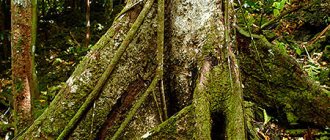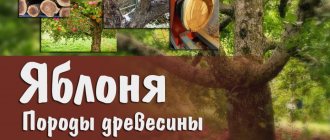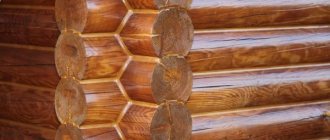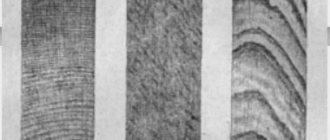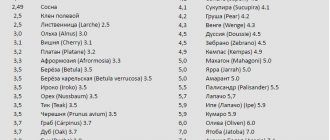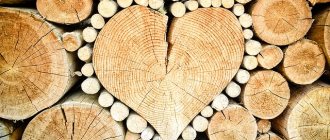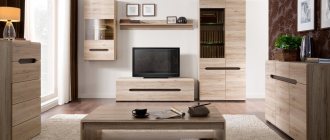In this article I will talk about wood and its types.
As we all know, it is impossible to make a craft without wood. Nowadays, there are a lot of types of wood that are different in quality, hardness, softness, color, properties, etc.
Wood can react to climatic conditions. For example, if you store plywood in a warm, unventilated area, the plywood will deteriorate over time.
Wood consists of elongated thin cells, like straws, that conduct water and dissolved minerals from the roots to the leaves, where the light produces organic substances necessary for tree growth. The wood of each species has cells that are characteristically located only in that species.
Wood can be soft or hard.
Types of wood:
Pine
(soft breed)
There are many varieties of pine, widely used in construction and for the manufacture of certain types of furniture.
Red tree
(hard rock)
The species, native to Honduras and Africa, is widely used in furniture production, usually in the form of veneers.
Elm
(hard rock)
A good general purpose material used in shipbuilding, as a structural material and for turning.
Cedar
(soft breed)
Lightweight and durable, cedar wood turns gray over time. Used for making stairs and window frames.
Douglas fir, or otherwise Liarsuga
(soft breed)
Very tall trees, the wood of which is used as a structural material in furniture and plywood production.
Beech
(hard rock)
The wonderful fine-grained beech wood is suitable for furniture, woodturning and toy making, but not for outdoor products.
Oak
(hard rock)
Very strong and durable oak wood is necessary for construction work and in the manufacture of furniture.
Chinara
(hard rock)
Light wood. Used in the manufacture of furniture and small parts, such as turning products.
Teak
(hard rock)
Heavy and durable teak wood is used in carpentry, furniture production and shipbuilding.
Birch
(hard rock)
Moderately hard birch wood is widely used in carpentry and furniture production.
Bog oak
(hard rock)
Stained European oak, which has a brown color, is highly valued as a facing material for furniture.
Ebony
(hard rock)
It has extremely hard and expensive wood. Used in the manufacture of keys for musical instruments, chess pieces, etc.
Larch
(soft breed)
Moderately soft larch wood is used both in furniture production and for the manufacture of piles, posts, sleepers, and floors.
Black walnut
(hard rock)
An excellent material for making furniture and turning products.
Ash
(hard rock)
Very hard and durable ash wood is used to make tool handles and sports equipment. Excellent material for turning work.
Afromosia
(hard rock)
Grows in West Africa. Used in the manufacture of furniture. Sometimes it stains under mahogany.
Silver maple
(hard rock)
Part of the maple wood with marks from underdeveloped branches is used in the form of veneer.
American linden
(hard rock)
Lightweight hardwood. Used to make cases, toys, and some types of furniture.
Entandrophragm
(hard rock)
Grows in Africa. It is used to make decorative furniture, usually in the form of veneer.
Trees with very hard wood
Ironwood is a very hard, heavy and dense wood that sinks in water, withstands high loads and is capable of outstripping even some metals in terms of strength.
The term "ironwood" applies to several types of trees growing on our planet. They differ from each other in appearance, are distributed in different parts of the Earth with different climatic conditions, but they are united by the incredible density of wood. Content:
- Parrotia persica
- Casuarina
- South frame
- Mesuya iron
- Pohutukawa
- Boxwood
- Hmelegrab
- Backout tree
- Iron birch
The wood of such trees has one property in which they bypass even metals - they are not subject to corrosion...
Ironwood trees have wood with little or no annual rings visible.
Mother Nature gave iron trees the ability to resist the effects of parasites, fungi and rot, and, of course, such properties (along with the highest density) could not but interest people.
Iron trees grow very slowly, their age often exceeds two hundred or even five hundred years, and many of them are listed in the Red Book. People usually use mature trees rather than young growth, and it is clear that such wood is quite expensive.
Let's talk about different types of iron trees, their characteristics, scope of application and other interesting facts.
Parrotia persica
Parrotia persica
Parrotia is found in Azerbaijan and Iran. The average lifespan of a tree reaching 30 meters in height is 200 years. Parrotia has a fairly short trunk with spreading branches that tend to intertwine with the crowns of trees growing nearby. People often use this feature of parrotia and make hedges out of them that are literally impenetrable.
Parrotia is especially beautiful during flowering. Just imagine what a flowering parrotia fence looks like!
It is no coincidence that the tree is called “iron tree”. Parrotia Persiana wood is not only very strong (stronger than iron) and heavy (much heavier than oak), but also has a beautiful brownish-pink color. In ancient times, warriors made edged weapons (sharpened stakes and spears) from it; now the wood is used to make flooring, furniture, window frames and shuttles for looms.
And this despite the fact that this material is not cheap - one beam measuring 12*4*3 cm costs an average of 500 rubles!
Azerbaijani relict forests of parrotia are a UNESCO World Heritage Site.
Casuarina
On the left is a casuarina tree, on the right is a cassowary.
The long thin leaves of young shoots of casuarina are very similar to the soft feathers of cassowaries - large Australian birds. Hence the name.
This iron tree is common in countries with warm climates. It is used as an ornamental plant, tannins are extracted from the bark, and the wood is used to make furniture; the remains are used as fuel and to produce coal. Moreover, casuarina firewood is considered the best because it produces the highest quality coal that can retain heat for a long time.
In India and China, casuarina wood is used as fuel in steam locomotives and brick kilns.
Casuarina is also used to make flooring, furniture, wall panels, and plywood.
Wood from freshly felled casuarina is easy to process, but dry wood is very difficult. This happens not so much because of the hardness of dry wood, but because of its unevenness - it has a lot of core rays, which are difficult to cut and plan during the processing process, resulting in unevenness. Yes, and it is difficult to dry casuarina wood, since it tends to crack, and the process can take several months.
But the wood of casuarina is beautiful - yellowish-brown, with a reddish kernel, and it is because of the color of the kernel that casuarina is also called “meat tree”.
South frame
Southern hackberry
Another name for southern hackberry is nettle tree because its leaves are very similar to nettle leaves.
The southern hackberry grows in Mediterranean countries. This iron tree, unlike others, grows quickly and reaches 25 meters in height. And he lives on average up to 500 years, although in some places there are also thousand-year-old skeleton elders. But they are of little use: on the outside they have a dense bark, inside of which there is rotten wood, crumbling down, and huge voids. Like people, despite the outer shell, no one has canceled their biological age.
The durable and hard wood of the yellow-green frame lends itself well to processing. For many centuries people have been using it in construction and making various crafts (including amulets). Nowadays wind musical instruments are also made from it.
Mesuya iron
Iron mezuya
From the name it is clear that mezuya is also an iron tree with very hard wood.
Iron mesuya grows in Sri Lanka. A mature tree is 30 meters in height and has a trunk of two meters in girth.
Its dark red wood contains toxic substances, but despite this, it is widely used by people. Construction, the production of plywood, machine parts, artistic masterpieces and pharmaceuticals - in all these areas there is an honorable place for durable mesuya wood.
In Sri Lanka, on an area of almost one hundred hectares, there is a National Park, founded more than 13 centuries ago, where iron mesui grow.
Pohutukawa
Pohutukawa
Pohutukawa is an endemic ironwood tree that grows wild in northern New Zealand. However, pohutukawa is now successfully grown in California, Australia and South Africa.
The tree has many trunks and a spreading crown, which is especially beautiful at the time of flowering.
Pohutukawa is grown as an ornamental plant, and you must admit, it is truly beautiful. Its wood is not used. Perhaps abroad - due to the small distribution of trees, and in New Zealand - due to the attitude of local residents (there are many legends associated with pohutukawa in which this tree is associated with the spirits of the dead).
Moreover, in some areas of South Africa, the spread of pohutukawa is considered a threat to biodiversity, meaning it is undesirable.
Boxwood
Boxwood
This iron tree has been valued by people for many millennia. Its beautiful yellow wood, similar to amber, has been prized since ancient Greece.
There are many legends about boxwood, and each of them glorifies some properties of the tree.
One legend is like this. Many, long ago, enemies decided to seize the lands belonging to the good people. Everything attracted them here - high mountains, stormy rivers, and lush vegetation. The villains caught a boy tending sheep and wanted him to show them the way to the settlement. The boy agreed, but asked for money for it. The enemies agreed and paid the boy a tidy sum. The shepherd led the enemies through mountains and valleys, and finally led them to a wide and stormy river, not far from which stood tall trees - these were boxwoods. The enemies rejoiced because on the other bank they saw the houses of the village, cultivated land and people...
But how to get to the other side? It would be impossible to wade or swim - the river carried its waters incredibly fast; It is also impossible to throw a tree trunk from bank to bank - the river is wide. And then the boy said that there was one way to get to the village - to cut down several trees, make boats out of them and cross the river on them.
This is what the villains did - for several days they felled trees and built boats from them, and this was difficult, since their wood was like iron. Finally, the job was done. The enemies quickly launched the boats into the water, jumped into them and set sail from the shore. But then something happened that the villains could not even think about - the boats quickly began to sink. Some invaders jumped out of them and tried to swim, but the stormy river carried them away, while others sank along with the boats. So the smart boy not only saved his native village, but also brought money to the villagers.
Boxwood planks
Here's another legend. One day, the Almighty ordered a raven to sprinkle water from a holy spring on people’s heads so that they would become, if not immortal, then at least long-lived. But the raven decided to use this water for his own benefit, that is, to sprinkle himself with it. He took water into his beak, flew to the boxwood, sat on it and, raising his crow's head, wanted to spit out the water so that it would fall on him. But bad luck - the raven missed and all the water poured onto the tree. Since then, boxwood has become a long-living evergreen. And it was then that toxic substances appeared in all parts of the boxwood, protecting it from pests.
Therefore, boxwood honey should not be consumed, but making a hedge is a great idea! Also, despite its toxicity, its wood has always been widely used. Chess, dishes, smoking pipes, musical instruments, and various artistic items were made from it.
In the 19th century, most of the boxwood plantings were cut down, so now all boxwood forests are under government control and tree felling is strictly regulated. And producing something from this wood is clearly an unprofitable idea, because one kilogram of it costs more than one thousand rubles.
Hmelegrab
Hmelegrab
Hmelegrab - an iron tree of the birch family - is common in places with warm climates. Previously, hop hornbeam wood was used to make tools for agricultural work, dishes, shoes, and various crafts. But after several centuries of uncontrolled cutting down of these trees, their number on our planet has sharply decreased, and now the hop hornbeam is listed in the Red Book.
Backout tree
Backout wood
Backout (or guaiac) wood is an ironwood common in the Caribbean, India and Central America.
Guaiac wood (the heaviest wood currently sold) has a greenish color. It is used to make hammers, bowling balls, cricket clubs, propeller shaft bearings in shipbuilding, furniture veneer, knife handles and, until recently, even batons for British police officers. Guaiacol resin, used in pharmaceuticals, is also extracted from it.
The main structures of St. George's Cathedral in Georgetown (Guyana), as well as the axis for the main shaft of the Varshavyanka submarine, are made from buckout wood.
Iron birch
Iron birch
Iron birch is an iron tree, a long-liver of the taiga of the Far East (lives up to 350 - 500 years), the owner of incredibly hard and heavy wood.
An interesting fact from the life of the iron birch. At a young age (up to 150 years), these birches are very similar to the birches known to us - just as white-trunked and slender. But with age, noticeable changes occur in their appearance - the bark first becomes gray, then thickens and resembles tiles, and little remains of its former grace...
Iron birch wood is difficult to process. The indigenous inhabitants of the Far East built their homes and boats using it. It is also used to produce durable joinery and turning parts, plywood, lumber, furniture, cookware, tools and art products.
Wood Density
As you know, wood density and humidity levels are directly related. Therefore, for comparison, all workpieces lead to a single moisture level indicator - 12%. It is generally accepted that heavy wood has an increased margin of safety, while light wood is considered less reliable. Based on moisture content, wood is divided into three groups:
- Low-density species (pine, spruce, fir, cedar, poplar, linden, willow, walnut, chestnut);
- Medium density species (larch, yew, birch, beech, elm, pear, oak, elm, elm, maple, plane tree, rowan, apple, ash);
- High-density species (acacia, birch, boxwood, pistachio, dogwood);
The quality and hardness of wood is determined by several criteria. Below we will look at each of them in detail:
- Wear resistance. This concept refers to the ability of wood to resist corrosion and wear caused by friction of the material. Wear decreases with increasing hardness of the workpiece, and it is also characterized by uneven distribution over the surface of the workpiece. The lower the moisture content of the wood, the higher the wear resistance.
- Impact strength. The concept of impact strength refers to the ability of wood to absorb impact. Its level is determined by testing the workpiece for strength by dropping it onto an iron ball. On average, deciduous trees show 2 times better results than coniferous trees.
- Flexibility of wood. Obviously, this concept refers to the ability of wood to bend. Coniferous varieties have a low bending ability, while ring-shaped varieties (ash, oak) have a much higher ability. The flexibility of wood is important, first of all, in the manufacture of individual parts, where the wood has to be wetted or heated, and then given a special shape.
- Deformability. Wood is characterized by a rare property: at certain levels of load, small deformations are formed in the workpiece, which disappear along with the load. The main indicator of deformability is elasticity, which increases with the level of humidity of the product. When drying, some of the blanks lose the elasticity and natural flexibility of the wood, and along with it the ability to resist deformation.
From all of the above, we can conclude that the quality of parquet is determined by the principle “the higher the hardness of the wood, the higher the reliability of the parquet,” and the hardness itself is expressed by the Brinell value, that is, the difference in the hardness of different types of wood. On the other hand, no type of wood is able to withstand constant point loads from the legs of heavy furniture and the like, and the quality of the parquet itself only affects its durability and appearance.
Varieties of "iron trees"
As mentioned earlier, there are many trees with high hardness ratings that are classified as “iron trees”. Among the most widely used in production, construction, and for making furniture, the following can be mentioned.
Jatoba - Brazilian cherry
In the tropical forests of Central and South America grows a tree called the South American (Brazilian) cherry. The height of individual specimens can exceed 40 m. Young shoots, pubescent with small brownish hairs, form a wide crown. The compound leaves are composed of two pointed, crescent-shaped leaves measuring 7.5 cm in length.
The South American plant is not a relative of the cherry fruit tree, which is widespread in our country. Perhaps the plant received this name because of the wood, the core of which is dark red or deep orange. After cutting, within a week it very quickly acquires a dark, brick-red hue.
Jatoba is one of the hardest species (7 Brinell points) used for making furniture and decorative elements.
Sucupira
This is another representative of the South American flora, growing in the forest thickets of Colombia, Brazil, and Venezuela. Expressive texture, small, narrow yellowish or light veins on dull reddish-brown wood, lighter towards the edges, make it easily recognizable and very decorative. In addition to high hardness and strength, the distinctive quality of sucupira is the presence in the layers of wood of oily substances that prevent the development of diseases, damage by combs and other pests.
Hardness of about 5.6 points complicates the process of cutting wood, which requires strict adherence to technology, failure to comply with which can lead to damage to all harvested raw materials. But the processing (sanding, polishing) is quite simple, which makes it possible to obtain from it a high-quality, beautiful parquet flooring in a wide range of colors from cocoa with milk to a burgundy shade. Products made from sucupira do not fade under the influence of ultraviolet rays and are not affected by fungus or harmful insects.
About 100 years pass from planting until the plant reaches maturity, but once the tree reaches 25 years of age, it can be processed. At this time, its trunk is almost cylindrical, devoid of side branches and shoots.
Turmoil
In the West African tropical rainforests, a very interesting tree grows, reaching 50-60 m in height, with a trunk diameter of about 1 m. The color of its wood resembles the color of a walnut, and the structure is teak. This type of wood is called mutania. It belongs to the “iron” category, since its hardness value is 5 points. However, this value is not always sufficient and in some cases it can be damaged by mechanical stress.
Muthenia wood is valued by furniture makers and builders because it does not crack or warp during the drying process, and when cut, radial rays of a violet hue “appear” on it. High hygroscopicity does not allow wood to be treated with varnish or primer. But you don’t need to do this, because it has an original natural shine. Furniture is made from muthenia wood, it is used for interior decoration, and is used in the production of parquet and veneer.
Intsia
Under the name merbau, wood of various types of intsia is widely used in European countries for the manufacture of parquet. Possessing high hardness (4.9 Brinell points), it is even suitable for laying floors in public buildings. In addition, it has increased moisture resistance, which makes it possible to use it in bathrooms, baths, and saunas.
The distribution area of Intsia is South Asia, Oceania, New Guinea, Madagascar. The plant belongs to the legume family. The height of individual specimens reaches 30-50 meters, the trunk diameter is 1.5 m. At the same time, there are practically no lateral branches on the trunk.
Merbau wood has a range of colors from light orange to yellow. After sawing, processing, and polishing, the surface of the wood becomes brownish and acquires a beautiful silver or bronze tint.
Canadian maple
The national flag of Canada is decorated with a stylized image of a maple leaf, since the sugar maple (Canadian) is a symbol of this country. Acer saccharum is a deciduous tree belonging to the Sapindaceae family. It occupies vast areas in North America. Maple also grows in our country, and recently it has been actively used in Europe as an ornamental plant to decorate gardens, parks, and public gardens.
The lifespan of one plant can be 400 years. During this time, it grows to 30-40 m in height, the thickness of the trunk reaches 1 m. The decorative appearance of the maple tree is given by its picturesque crown, consisting of small, about 11 cm in length and width, leaves of an original shape. In summer they are dark green, with the onset of autumn they acquire red, orange, and yellow shades.
In addition to its decorative properties, Acer saccharum has a sweetish-tasting sap, which can be collected in early spring and used in cooking, and durable, hard (4.8 Brinell points) wood, widely used for making furniture, expensive musical instruments, parquet, cladding panels, butts. for weapons and even bowling pins.
Yarra (eucalyptus)
In total, about 700 species of eucalyptus, trees from the myrtle family (Myrtaceae), grow in Australia. They grow very rapidly, especially at a young age, adding up to 5 m in height per year. The height of an adult plant is about 40-50 m. Among the features of eucalyptus: the ability to “shed” the bark in the fall, the arrangement of the leaves with their edges facing the sun, so they do not provide shade at all, the beautiful dark red to light pink color of the wood, the texture reminiscent of mahogany (mahogany) and high hardness (5 Brinell points).
Yarra – Eucalyptus marginata wood, dense, hard and flexible, can be easily processed: polished, sanded. But it has a drawback - it is very difficult to cut it perfectly straight. The main use of jarrah wood is decoration and cladding of yachts, boats, and buildings in areas with high humidity.
Pink tree
A very unusual tree, Dalbergia decipularis or bahia, grows in the Amazon jungle. It grows only in the subtropics of Brazil and is notable for its hard wood (4.4 Brinell points) with a beautiful texture, coloring from yellow to pink, with small red touches. But what is especially surprising is its smell. Bahia gives off an aroma characteristic of rose bushes. Because of this, the plant received another name - rosewood.
The wood is highly polished and used in furniture production, for the manufacture of musical instruments (recorders, guitars), gift boxes for cigars (humidors), and for wood carving. But still, its main value is its essential oil, which has antiseptic and bactericidal properties. It is widely used in cosmetology, dermatology, and is used as an analgesic and sedative. In addition, it is a powerful aphrodesiac.
Ash
Ash, which can be found in almost all corners of our country, has elastic, durable and hard (4.0 Brinell points) wood. It belongs to the Maslinaceae genus and, with an average height of 25-35 m, can sometimes reach a height of 60 m. The diameter of the trunk usually does not exceed 1 m. The special hardness of ash wood was noticed by the ancient Novgorodians. They used it to make combat (bows, clubs) and hunting (horns, spears) weapons.
Oak
In our country, oak is a kind of standard of hardness. We say: “Strong as an oak” when we want to emphasize the character traits of a person who has a strong will and determination. However, when compared with other “iron” trees, its hardness is not that great, only 3.8 Brinell points. Oak, a member of the Beech family, can grow both as a tree and as a shrub. Depending on the growing conditions, its wood varies in strength, strength, and heaviness. It is used as an ornamental wood, for the production of furniture, musical instruments, and as timber.
Hardness of wood species
The hardness of timber is its ability to resist the penetration of harder bodies, for example, nails and screws.
The hardness of wood varies in different cutting directions. The following types of hardness are distinguished:
- end This type of hardness is determined by pressing a metal rod, which has a hemispherical end with a diameter of 11.28 mm. The rod is pressed to a radius depth of 5.64 mm gradually over 2 minutes. The size of the print is 1 square centimeter and therefore hardness is measured in kg/cm2
- radial
- tangential
The lateral hardness of coniferous varieties of timber is most often 40% lower than the end hardness, and for deciduous varieties it is approximately 30%. The tangential type of hardness, for example, of oak, beech or elm timber is almost 5-10% higher than the end hardness. Most types of wood have approximately the same tangential and radial hardness.
In order to create a high-quality product from wood, it is necessary to determine the hardness of the type of wood used. Most often, the Brinell method is used to determine hardness. The meaning of this method is to press a metal ball with a diameter of 10 mm into the surface of the workpiece with a force of 100 kg. The hardness value is determined by the type of deformation and the diameter of the resulting depression.
In addition, experienced craftsmen must take into account changes in hardness that may occur while working with workpieces. For example, the hardness of timber varies depending on the type of cut.
